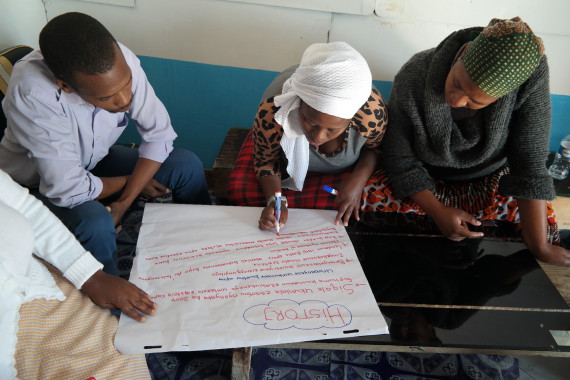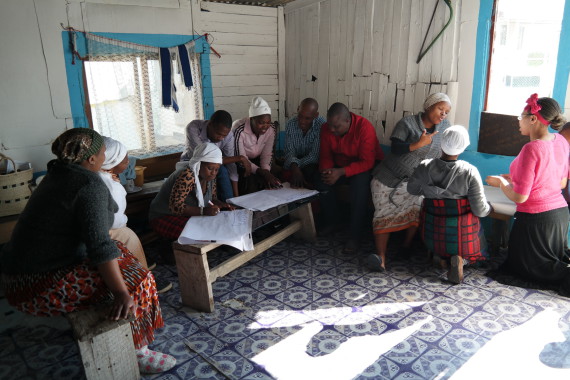By Santini Community Members (on behalf of ISN)

This blog was written by Santini’s community documenters depicted in this picture: Veronica Lebakeng, Nwabisa Ndzendze, Bathandwa Yengeni, Loniswa Dumbela. Grace Lebakeng, Thobela Nqophiso, Thulie Lebakeng, Thanduxolo Bayibile, Melikhaya Nqopiso, Likuwe Bayibile
For the SA SDI Alliance community-generated documentation is an integral aspect of community-driven process. This means that communities are not only best positioned to take a central role in driving their own development interests but also to speak about and document their experiences in community organisation processes such as informal settlement upgrading . For communities it is evident that
“No one can tell our story better than we can”
In Mfuleni, Cape Town, community leaders in Santini informal settlement have been involved in pioneering a community-centred documentation approach in the Alliance. Through a series of workshops they have used ‘story-telling and writing’ to record and document their story. This includes Santini’s experience of community mobilisation and preparation for upgrading as well as personal accounts of realities, challenges and desired alternatives.By documenting their own experiences, community members are building a voice of the urban poor from the bottom up.
This is the first in a series of blogs entitled “Community Voices”, written by community residents, who introduce their settlement and share their story.
History of Santini
Santini is called Santini because it was once an open space with a lot of sand [in isiXhosa “isanti” means “sand”]. We started living in Santini in 2004 with most people coming from the Eastern Cape. We were living as backyarders in the surrounding formal houses before they [plot owners] got RDP houses.
There came a time when the plot owners [formal homeowners] had to move to an open space (which was already called Santini) because their RDP houses were going to be built. The backyarders moved to Santini as well. We [backyarders] weren’t allowed back into their plots when the houses were done, some claimed that they didn’t have space anymore.
In 2004 there were 8 shacks in Santini, but today there are 43 shacks including the ones brought in by the South African National Civic Organisation (SANCO). We don’t feel safe because people in [the formal houses] claim the land [Santini] belongs to their children and not to us [as former backyarders]. Apparently their children are in need of a place to reside, so the people in the formal houses approached SANCO to resolve the matter. It was agreed via SANCO that the residents’ children can reside in Santini too.

Thanduxolo, Santini community leaders with steering committee members record their memory of Santini’s history
Our Reality Now
These are the things we need:
Electricity
We don’t have proper electricity. We rely on connections from the formal houses, and we pay R150 monthly. If the electricity ends before the month ends, we are required to pay more. If we do not pay more money, our tap will be unplugged. The connections are dangerous. When a big truck passes by the wires break, and they can shock the children when they are playing.
Taps
In Santini we have only one tap and there are many people living here so we hold a long queue when we need water. We cannot get water at night because of safety.
Toilets
We have a total of 7 toilets, but only 4 are working and are far from us. We fear to use the toilets at night. We fear to be mugged because of the darkness.
Roads
We don’t have proper roads, so emergency services are unable to assist the community in times of need like when someone is sick or there is a fire.
Proper Houses
We don’t have proper housing, and the structures that we are living in is old. We can’t even extend because we have no land of our own. Some people have extended families, and it’s hard to live in a one-room house with everyone.
Streetlights
Since we have no street lights we fear going outside during the night because it’s dark. It’s risky to go because we fear being mugged.
Dust Bins
Our place is filthy because we don’t have a place or dust bins to drop unwanted materials.
Drains
We don’t have drains so people use toilets as an alternative and that results in the blockage of the toilets.
Solutions
We need electricity, water, toilets, and proper houses. The ideal solution is to get more toilets or each household to get their own toilet to avoid waiting for people when one wants to use the toilet.
We, as a community of Santini, decided to seek help from the Informal Settlement Network (ISN). We told them about our living conditions and challenges as a community.Nkokheli Ncambele [Western Cape coordinator of ISN] is the one who introduced us to ISN. After the introduction to the [SA SDI] Alliance, we attended their meetings [and understood the processes] . [After some negotiation] toilets were installed by the municipality. We then began [Alliance] processes like enumerating our settlements. ISN also introduced us to the tools of profiling, community designing and learning exchanges. During profiling, we measured the existing structures. We used the enumeration to record the number of people living in Santini and their activities. A group of us went on a visit to see Flamingo Crescent and to be educated about the re-blocking of Flamingo Crescent.



